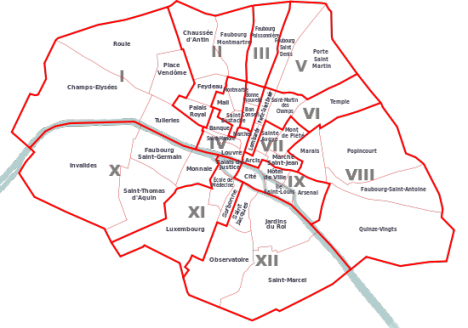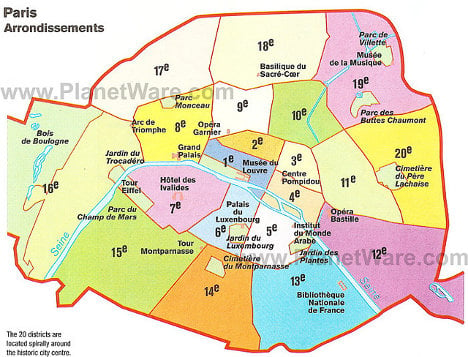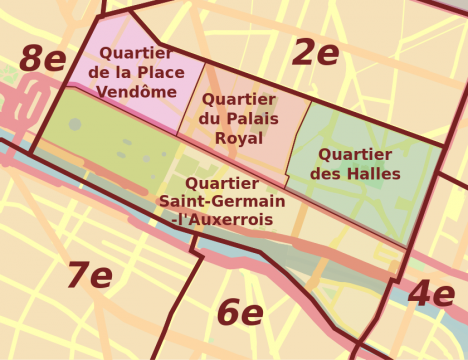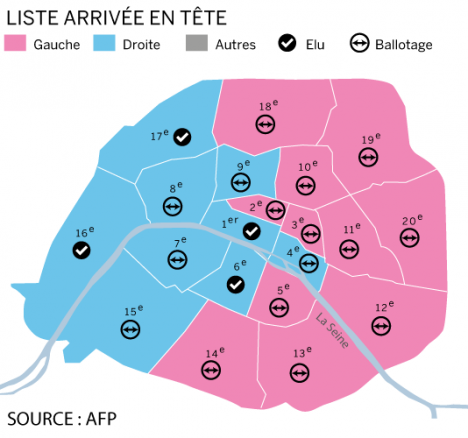Paris arrondissements: Facts you need to know

We take a stroll through the sometimes surprising history of the French capital's arrondissements.
Paris mayor Anne Hidalgo has said she wants to redraw the city's map so before the current arrondissements become a thing of the past, here's some facts you need to know.
Yes, it's all Napoleon's fault (Not Bonaparte)
Paris was first divided in arrondissements back in 1795 although back then there were only 12, nine on the right bank and three on the left. As the map below shows the numbering and borders of each district bare little resemblance to today's first 12 arrondissements.
It was in 1860 under Napoleon III that Paris grew to 20 arrondissements, when the city ‘s territory was expanded to include territory outside the old limits. The previous 12 arrondissements were all rearranged to give us the city's current layout.

What's with the snail shell shape?
The story goes that Paris settled on a spiral pattern for the numbering of its arrondissements when the number of districts was extended from 12 to 20. Original plans for right to left numbering (with the 20th arrondissement being the furthest west) were supposedly rejected because it would have seen the rich inhabitants of the current 16th living in the 13th – a problem because of an old expression “to get married at the town hall of the 13th arrondissement” which basically meant to be living in sin.
After a huge hullabaloo over which area would be assigned the 13th arrondissement, it was decided that the best option would be the south east of the city on the left bank which back then was cholera-riddled slum.

Size matters
When it comes to the arrondissements of Paris, some are more equal than others. The arrondissements are not all the same size, and the populations are wildy different. While the 1st arrondissement is home to just 17,000 residents, the 15th has 240,000 people calling the area home.
While the biggest in area is the 16th which measures 7.8 km square (16.3km squared including the Bois de Boulogne), while the smallest is the 2nd at just under 1km squared.
One arrondissement = four quarters
If you ask a Parisian where they live, most will tell you the number of their arrondissement, but the odd person might tell you there specific "quartier".
Because although they are rarely referenced, each of Paris's 20 arrondissements are actually split into four quarters, each with its own name. So the 1st arrondissement is made up Place Vendôme, Palais-Royal, Les Halles and SAint-Germain L'Auxerrois.

The great political divide
When it comes to voting, there is a pretty serious left-right divide in Paris as the map below shows - in that the arrondissements on the left of the map (or west to use the proper term) vote right and those on the right of Paris vote left.
The map below shows the division after the 2014 local elections, which clearly shows the wealthy more traditional arrondissements to the west of the city almost always vote for the centre right party and those on the east, which have more working class districts vote Socialist.

What's in a word?
The word arrondissement comes from the French verb arrondir (to encircle). It is sometimes translated into English as ‘district’ but more often left unchanged – The Local’s preference - as no English word quite captures the four-syllable roll of the original.
Real estate prices
Property is not exactly a bargain in any of the Paris arrondissements, but prices do vary. The most expensive real estate in Paris is in the 6th arrondissement where costs were an average €12,620 per square metre in 2014. At the other end of the scale is the 18th where a square metre would set you back €7,230 per square metre.
The wealthiest arrondissement?
Although the 16th is home to the most millionaires, the wealthiest arrondissement on average is actually the 7th where the typical salary is €94, 000 a year compared to €86, 000 in the 16th and there are more residents on average who have to pay France's fortune tax (ISF) than any other arrondissement.
At the other end of the scale is the 18th arrondissement which has the lowest annual average wage of €31, 500.
Getting up close and personal
If you want big skies and wide open spaces, don't come to Paris: it's among the world's most densely populated cities. Even here, though, there are differences. At the busy end of the scale, the most densely populated arrondissement is the 11th with 41,598 inhabitants per square kilometre. By contrast, in the 1st arrondissement that figure is a much more comfortable 9,693.
City limits
The borders of Paris have basically been the same since 1860 but slight revisions of the area covered by the arrondissements saw it growing until 1954 when it reached its current size of 10 540 hectares.
A quoi pourrait ressembler la nouvelle carte de Paris ? >>http://t.co/ABRP6cPCmd pic.twitter.com/yQ2FKyYDJ2
— Le Parisien | Paris (@LeParisien_75) September 23, 2015
(A projection of what the new Hidalgo-designed map of Paris could look like, according to Le Parisien newspaper.)
Comments
See Also
Paris mayor Anne Hidalgo has said she wants to redraw the city's map so before the current arrondissements become a thing of the past, here's some facts you need to know.
Yes, it's all Napoleon's fault (Not Bonaparte)
Paris was first divided in arrondissements back in 1795 although back then there were only 12, nine on the right bank and three on the left. As the map below shows the numbering and borders of each district bare little resemblance to today's first 12 arrondissements.
It was in 1860 under Napoleon III that Paris grew to 20 arrondissements, when the city ‘s territory was expanded to include territory outside the old limits. The previous 12 arrondissements were all rearranged to give us the city's current layout.

What's with the snail shell shape?
The story goes that Paris settled on a spiral pattern for the numbering of its arrondissements when the number of districts was extended from 12 to 20. Original plans for right to left numbering (with the 20th arrondissement being the furthest west) were supposedly rejected because it would have seen the rich inhabitants of the current 16th living in the 13th – a problem because of an old expression “to get married at the town hall of the 13th arrondissement” which basically meant to be living in sin.
After a huge hullabaloo over which area would be assigned the 13th arrondissement, it was decided that the best option would be the south east of the city on the left bank which back then was cholera-riddled slum.

Size matters
When it comes to the arrondissements of Paris, some are more equal than others. The arrondissements are not all the same size, and the populations are wildy different. While the 1st arrondissement is home to just 17,000 residents, the 15th has 240,000 people calling the area home.
While the biggest in area is the 16th which measures 7.8 km square (16.3km squared including the Bois de Boulogne), while the smallest is the 2nd at just under 1km squared.
One arrondissement = four quarters
If you ask a Parisian where they live, most will tell you the number of their arrondissement, but the odd person might tell you there specific "quartier".
Because although they are rarely referenced, each of Paris's 20 arrondissements are actually split into four quarters, each with its own name. So the 1st arrondissement is made up Place Vendôme, Palais-Royal, Les Halles and SAint-Germain L'Auxerrois.

The great political divide
When it comes to voting, there is a pretty serious left-right divide in Paris as the map below shows - in that the arrondissements on the left of the map (or west to use the proper term) vote right and those on the right of Paris vote left.
The map below shows the division after the 2014 local elections, which clearly shows the wealthy more traditional arrondissements to the west of the city almost always vote for the centre right party and those on the east, which have more working class districts vote Socialist.

What's in a word?
The word arrondissement comes from the French verb arrondir (to encircle). It is sometimes translated into English as ‘district’ but more often left unchanged – The Local’s preference - as no English word quite captures the four-syllable roll of the original.
Real estate prices
Property is not exactly a bargain in any of the Paris arrondissements, but prices do vary. The most expensive real estate in Paris is in the 6th arrondissement where costs were an average €12,620 per square metre in 2014. At the other end of the scale is the 18th where a square metre would set you back €7,230 per square metre.
The wealthiest arrondissement?
Although the 16th is home to the most millionaires, the wealthiest arrondissement on average is actually the 7th where the typical salary is €94, 000 a year compared to €86, 000 in the 16th and there are more residents on average who have to pay France's fortune tax (ISF) than any other arrondissement.
At the other end of the scale is the 18th arrondissement which has the lowest annual average wage of €31, 500.
Getting up close and personal
If you want big skies and wide open spaces, don't come to Paris: it's among the world's most densely populated cities. Even here, though, there are differences. At the busy end of the scale, the most densely populated arrondissement is the 11th with 41,598 inhabitants per square kilometre. By contrast, in the 1st arrondissement that figure is a much more comfortable 9,693.
City limits
The borders of Paris have basically been the same since 1860 but slight revisions of the area covered by the arrondissements saw it growing until 1954 when it reached its current size of 10 540 hectares.
A quoi pourrait ressembler la nouvelle carte de Paris ? >>http://t.co/ABRP6cPCmd pic.twitter.com/yQ2FKyYDJ2
— Le Parisien | Paris (@LeParisien_75) September 23, 2015
(A projection of what the new Hidalgo-designed map of Paris could look like, according to Le Parisien newspaper.)
Join the conversation in our comments section below. Share your own views and experience and if you have a question or suggestion for our journalists then email us at [email protected].
Please keep comments civil, constructive and on topic – and make sure to read our terms of use before getting involved.
Please log in here to leave a comment.